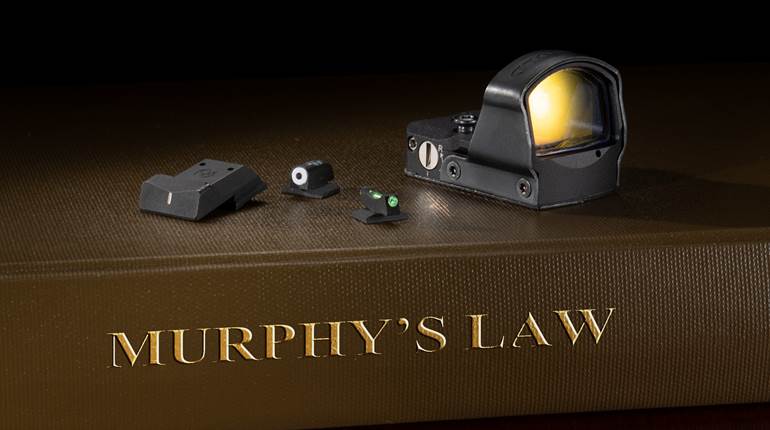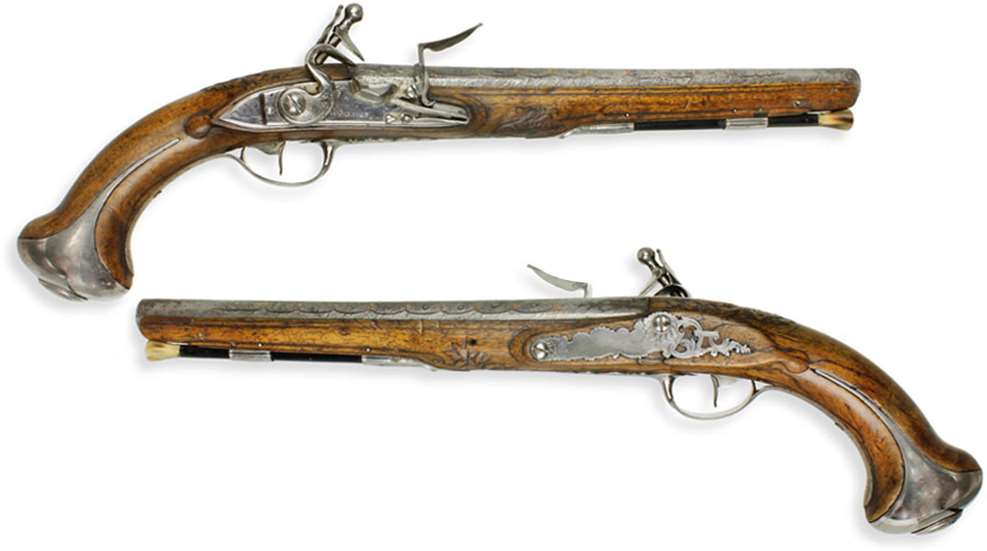
The Lafayette/Washington pistols were made to be carried on horseback in holsters secured to the pommel of a saddle. They are reputed to have been carried by Washington at Valley Forge, Monmouth, Yorktown and, later on, during the Whiskey Rebellion when Washington was president.
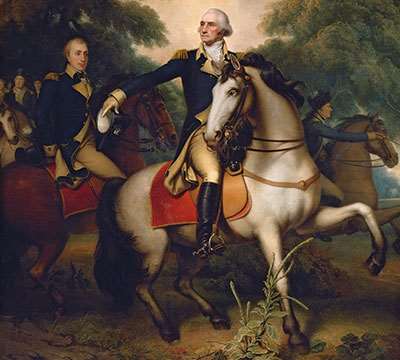
On Aug. 16, 1824, an American merchant ship sailed from France into New York Harbor with the last living major general from the American Revolutionary War on board—Gilbert du Motier, Marquis de Lafayette. The marquis had been cordially invited by then-President James Monroe, accompanied by a formal request from Congress to visit the United States as “The Nation’s Guest.” Perhaps, as Lafayette was sailing across the Atlantic, he pondered what his reception might be in the country for whose democratic form of government he had fought so hard and sacrificed so much. After all, the American Revolution was nearly half a century old and he was now in his 70s.
If Lafayette was concerned at all whether Americans remembered or cared about him, he needn’t have been. We do not hear much about Lafayette these days, but at that time, he was already well-beloved and recognized in the public’s eye as a bonafide hero of the American Revolutionary War. But the aging marquis had no idea just how popular he had become and how meaningful his visit to the United States would be—and that he would be reunited with the two pistols he had given to his close friend, George Washington.
As the merchant vessel neared land, dozens of ships were anchored in the harbor with flags flying, and church bells rang with tens of thousands eagerly waiting on the shores to welcome him. Thirty thousand people greeted him on lower Manhattan; 50,000 on Broadway stood and watched as he was escorted to city hall. Veterans from the war stood by, some in their old, ill-fitting uniforms, and hailed him as he passed; and at every stop, the aging general would take time to shake hands with them. Wherever he traveled in the months ahead, including battle sites, the multitudes showed up in huge numbers to see him. Some waited in line all night long just for the privilege. In Boston alone, 200,000 packed the streets during his visit to help celebrate the anniversary of the Battle of Bunker Hill. Noted historian Harlow Giles Unger wrote, “What began as a four-month tour would stretch into a thirteen-month triumphal procession over six thousand miles, through all twenty-four states, from New Hampshire to South Carolina, across the south to New Orleans and up the Mississippi by steamboat to St. Louis. Crowds of fifty thousand to one hundred thousand turned out to see and cheer him in every city; even small towns drew throngs of ten thousand or more from miles around. From St. Louis, he traveled through Tennessee, Kentucky, Ohio, and western Pennsylvania, then up to Buffalo and Niagara Falls, before returning east.”
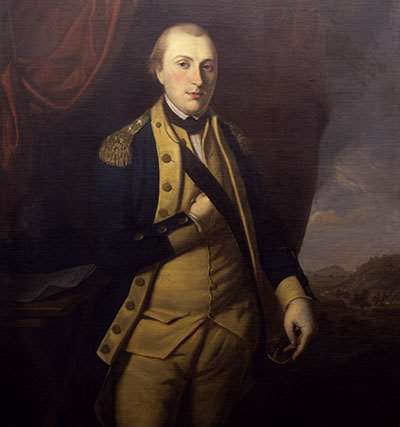
On May 25, 1825, while traveling through Tennessee on his nation-wide journey, the marquis stopped by to visit Andrew Jackson at The Hermitage, Jackson’s plantation home. While there, Jackson brought out a beautiful pair of matched pistols, presented them to Lafayette and asked if he recognized them. Picking them up, the marquis smiled and remarked that, indeed, he did recognize them. He had given them as a gift to his “paternal friend,” George Washington in 1778 at the height of the American Revolutionary War.
Recently, accompanied by Larry Spisak, Judith Hudnall and Gene Shadley, I enjoyed the privilege of examining and photographing those pistols.
In 2002, at Christie’s Americana Auction House, the Lafayette/Washington pistols were sold for a whopping $1,986,000 to a local Pennsylvania foundation. The foundation purchased them in commemoration of the 250th anniversary of the French and Indian War—and in recognition of the critical role that Washington played, not only in that war, but in the birth of our democracy. In the spring of 2004, the foundation donated the pistols to the Fort Ligonier Museum in Ligonier, Pa., to be on display as part of the museum’s “Washington Collection.”
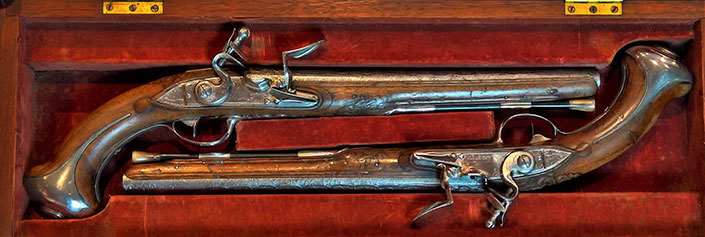
The Marquis de Lafayette was born Sept. 6, 1757, into an extremely wealthy family entrenched within one of the highest echelons of the French nobility. His childhood was visited at times with sorrow. Lafayette’s father was killed in battle when he was only 2 years old, and his mother died in his 12th year. So it was his grandmother who would have the most important influence on his upbringing. She was not like others in the French nobility who disdained and mistreated the peasant class. Unger wrote of Lafayette’s grandmother, “She was a woman of the highest character, respected throughout the province, universally venerated for her kindness and generosity. Hers was an islet of liberty in a sea of feudal oppression. Lafayette grew up with a deep affection for the adoring peasantry … he loved the land and loved the people, trusted them and respected them.”
During Lafayette’s teenage years he received training as a soldier, married at 16 and became a captain in a company of the Noailles Dragoons when he turned 18. The young marquis had already been exposed to Enlightenment philosophy (as were many of our Founding Fathers) and embraced it as a Freemason around the age of 17, espousing their beliefs in the right to life, liberty, religious freedom and property. His connection with Freemasonry would serve him well all of his life, and he became a very dedicated member of the fraternity. Lafayette also became acquainted around this time with the struggle between England and her Colonies, and quickly aligned himself with the American cause, deciding to travel to America to fight for liberty. So, on April 20, 1777, at 19 years of age, and a strapping 6'1" tall, the Marquis de Lafayette sailed to America, presented himself to the Continental Congress and asked for a commission as an officer in the Continental Army, pledging his life and sacred honor to the cause of American independence—and to serve at his own expense. He would do so throughout the war, even to the point of outfitting his troops with uniforms, supplies and arms, spending up to half of his considerable wealth in the process.
The Marquis de Lafayette was introduced to George Washington at a dinner party in Philadelphia on July 1, 1777. He was 19—Washington was 45. As a French officer who had volunteered to serve in the Continental Army, the young marquis had been given a commission by the Continental Congress. Washington was apprehensive at first about the young officer who could not even speak English and had never seen actual battle. Soon, however, the commanding general was won over by Lafayette’s dedication to the American cause, his unbounding enthusiasm, bravery, loyalty—and that he was a fellow Freemason. Over the course of the war, Lafayette would become like a son to him.
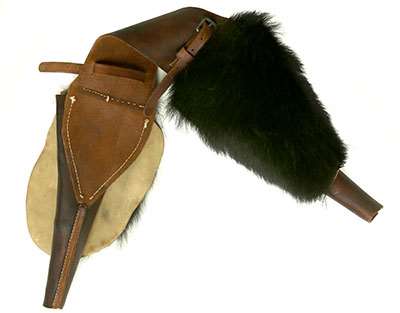
In Washington, Lafayette saw a dynamic leader, a man of sterling character and the father (and mentor) he never had. Together, during the fiery and trying crucible of the American Revolution, they would make invaluable contributions to the causes of liberty and democracy—the very foundations of our government and, in the process, forge a life-long, affectionate friendship.
Extensively researched by Christie’s Auction House, the pistols Lafayette gifted to George Washington are the most thoroughly documented of those known to have been owned by our first president. They are exquisite surviving examples of sidearms produced in the 18th century exhibiting both old-world craftsmanship and high-end art. Produced by French gunsmith Jacob Walster (who worked circa 1761-1790) in the city of Saarbruck, France (now in Germany), both are mounted in polished steel furniture. In rather an ironic twist, there exists another pair of pistols marked “Walster” in the collection of the Royal Family in Windsor Castle, allegedly purchased by King George III— England’s king during the American Revolution.
The architecture and basic layout of the pistols reveal careful design, skillful execution and creative expression. Virtually identical, they are stocked in fine European walnut, stained in a color that has mellowed over the years into a kind of a honey (or perhaps butternut) color, and are skillfully and tastefully graced with raised and incised carvings in rococo styling with both gold and silver inlays. Made circa 1775-1777, the total length of each pistol is 17½" with a smooth bore barrel of about .57 caliber. Yet when I hefted them, they did not seem heavy at all, and the balance and pointability were excellent. This is due, in part, to the graceful curve of the butt of the pistols that terminates with a bulbous knob capped with a pommel buttcap (with side stirrups). Also, the 11½" wrought-iron barrels are tapered from breech to muzzle, starting out octagonal for about a third of the barrel’s length and then flowing round to the muzzle, thereby reducing weight and improving balance. Both barrels are profusely engraved and finished off with applied silver and gold. Engraved on one of the pistol’s lock flats is the name “Walster,” on the lock of the other is “Saarbruck.” Both locks appeared to be in working condition.
The pistols themselves might be characterized as “saddle pistols,” meaning they were made to be carried on horseback, in holsters, either singly or as a pair, fastened at the front end (pommel) of the saddle with the butt ends normally pointed forward. Pommel holsters were made of heavy leather and generally had a protective top flap made of leather cloth or fur, and were standard equipment for most mounted officers and cavalry. The original holsters for the pistols have not survived, but a presentation case of black walnut was made to house and protect the heirlooms. It is thought that Washington carried the pistols at Valley Forge, Monmouth, Yorktown and, later, during the Whiskey Rebellion during his presidency.
The Lafayette/Washington pistols have an interesting chain of ownership, including by our seventh president, Andrew Jackson. After the president’s death in 1799, the pistols went to William Augustine Washington, Washington’s nephew. At a later date William give them to his son-in-law, William Robinson. Then, in 1824, William Robinson presented them to Andrew Jackson through Virginia Congressman Charles Fenton Mercer. It was while the pistols were in Jackson’s possession that the Marquis de Lafayette was able to verify that they had indeed been given to Washington by himself.
Robinson’s note to Andrew Jackson, dated Jan. 8, 1824, from Sudley, Va., reads: “Sir: be pleased to accept the pistols which were presented by the Marquis de Lafayette to General George Washington and worn by him in the service of his country. It fell to my lot to become, as one of the legatees of Gen. Washington, the proprietor of this interesting property and I cannot better dispose of it, than by transferring it to the successor of Washington in the military character of America. With perfect respect, I have the honor to be your fellow citizen and most obedient servant, Wm. Robinson.”
Congressman Mercer presented the pistols, along with William Robinson’s note to Jackson with these recorded words: “General: allow me to fulfill the request of a friend and constituent, Mr. William Robinson of Sudley, one of the legatees of General George Washington, by delivering to you, the arms that he [Washington] wore during the many vicissitudes of that Revolution which conducted him to the summit of renown and our country to independence. They were the gift of his distinguished pupil, Lafayette and associate, the name [referring to Lafayette] of the steadiest friend of Liberty in the Old [world], with the memory of her most brilliant and extraordinary champion in the New World … .”
During Lafayette’s visit to Jackson’s home, Auguste Levasseur—Gen. Jackson’s personal secretary—was present. He is quoted in writing as saying: “[T]hose arms which General Jackson wished to particularly direct our attention to were the pistols which he presented to General Lafayette and inquired if he [Lafayette] recollected them. After examining them attentively for several minutes, he replied that he did in fact recollect them as those that were offered in 1778 to his paternal friend Washington, that he experienced great satisfaction in seeing them again and that he rejoiced to see them in the hands of a man so worthy of such an inheritance.”
Jackson kept them in his possession until his death, and in his will bequeathed them to Lafayette’s son in France, George Washington Lafayette. Upon George’s death, the pistols passed on to his son, Edmond Lafayette, and when he died they went to Antonin de Beaumount, Edmond’s nephew. Edmond’s will states in part: “I bequeath with all title to my nephew Antonin de Beaumont, the pistols that belonged to Jackson, the Defender of New Orleans. The pistols came from General Washington, which were then bequeathed by Jackson to my father George de Lafayette.”
Madame Edmond Hennocque, Antonin’s daughter, became the next owner in the early part of the 20th century. In 1958, she sold the pistols to noted antique arms dealer in France, Charles Marcel, and he in turn sold them to Charles Dresser, a French private collector. After Dresser’s death they were sold by public auction in Paris in 1983 to a private party, and this man owned them until they were auctioned in 2002.
The Lafayette/Washington pistols are a national treasure in my opinion. Though they are inanimate objects, they are a living reminder of the time period and the struggles of our nation’s birth—and of the deep bond of friendship between two heroes of our American Revolutionary War. Further, the pistols are a grand testament to the quality and artistic expression of gun builders in the 18th century.
Finally, the Lafayette/Washington pistols should re-awaken our appreciation for Lafayette both as a soldier and as a diplomat. As an officer and soldier in the Continental Army, Lafayette proved his dedication and bravery. He was present at the battle of Brandywine, (he was wounded there) and a number of other important engagements including Valley Forge, Chester, Germantown, Gloucester, Saratoga, Monmouth and Yorktown. His troops loved him; he was a soldier’s type of general who did not look down on his men, asked their opinion on matters and even fought next to them.

One of his greatest contributions to the American Revolutionary cause was not on the battlefield but as a diplomat. He was a very effective lobbyist, sending a ceaseless flow of letters to French political and military persons of importance, describing the American war effort and encouraging them to aid the Continental Army. The French press printed his stories, helping sway public opinion toward the American war cause. Although others influenced the French court, Lafayette’s efforts were essential to garnering political and military support to the American Revolutionary cause, without which American victory would not have been realized.
Perhaps the depth of friendship between Washington and Lafayette can be appreciated in the letters they exchanged as Lafayette was getting ready to leave for France after the war had ended.
Washington wrote, “I owe it to your friendship and to my affectionate regard for you, my dear Marquis, not to let you leave this country without carrying with you fresh marks of my attachment to you and new expressions of the high sense I entertain of your military conduct and other important services in the course of the campaign.”
Lafayette responded, “Adieu my dear General. I know your heart so well that I am sure that no distance can alter your attachment to me. With the same candor, I assure that my love, respect, my gratitude for you are above expression. That at the moment of leaving you I felt more than ever the strength of those friendly ties that forever bind me to you … .”
At the conclusion of Lafayette’s American tour, in 1825, a huge silent crowd gathered at the White House to say goodbye to the marquis. The newly elected president, John Quincy Adams, (son of Founding Father and second president John Adams) addressed Lafayette: “We look upon you always as belonging to us, during the whole of our life, [and] as belonging to our children after us. You are ours by more than [the] patriotic self-devotion with which you flew to the aid of our fathers at the crisis of our fate; ours by that unshaken gratitude for your service which is a precious portion of our inheritance; ours by that tie of love, stronger than death, which has linked your name for endless ages of time with the name of Washington … . Speaking in the name of the whole people of the United States, and at a loss only for language to give utterance to that feeling of attachment with which the heart of the nation beats as the heart of one man, I bid you a reluctant and affectionate farewell.”
After Lafayette composed himself, he simply replied, “God bless you, sir; and all who surround you. God bless the American people, each of their states and the federal government. Accept this patriotic farewell of a heart that will overflow with gratitude until the moment it ceases to beat.”
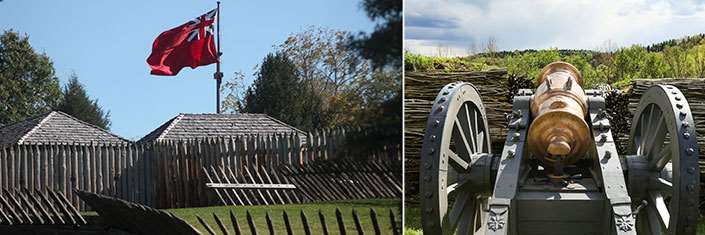
A Pair of National Treasures Recognized & Enshrined
In 1998, the NRA Gun Collectors Committee established a sub-committee to evaluate firearms of note that might be considered a cut above any others and worthy of “National Treasure” status. These arms would be recognized by a gold medal, suitably inscribed, to accompany the firearm henceforth.
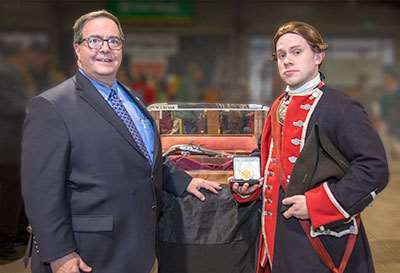
In September 2017, the committee selected the Jacob Walster-made pistols—once the property of the Marquis de Lafayette, President George Washington and President Andrew Jackson—to receive National Treasure medal No. 4. The medal was presented on March 18, 2018, at the Maryland Antique Arms Collector’s show.
Previous National Treasure recipients include: a Henry rifle presented to Abraham Lincoln; a cased Colt 1851 Navy belonging to Maj. Robert Anderson, the hero of Fort Sumter; and the Walker Colts once owned and used by Texas Ranger Capt. Samuel Hamilton Walker.
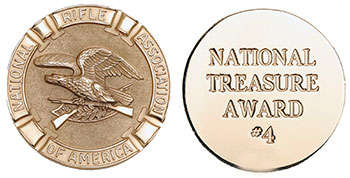 The current home of these exquisite and nationally renowned pistols is Fort Ligonier, southeast of Pittsburgh in Westmoreland County, Pa. Constructed in 1758, Fort Ligonier was visited by General Washington shortly after it was completed during the conflict now known as the French and Indian War. It was abandoned in 1766. Restoration began in 1946 and Fort Ligonier was placed on the National Register of Historic Places in 1975.
The current home of these exquisite and nationally renowned pistols is Fort Ligonier, southeast of Pittsburgh in Westmoreland County, Pa. Constructed in 1758, Fort Ligonier was visited by General Washington shortly after it was completed during the conflict now known as the French and Indian War. It was abandoned in 1766. Restoration began in 1946 and Fort Ligonier was placed on the National Register of Historic Places in 1975.
The Lafayette/Washington pistols are on display as part of “The Washington Collection,” which includes an original 11-page written summation of the French and Indian War composed by our first president. For more, go to fortligonier.org.
—Philip Schreier, Senior Curator, National Firearms Museum













